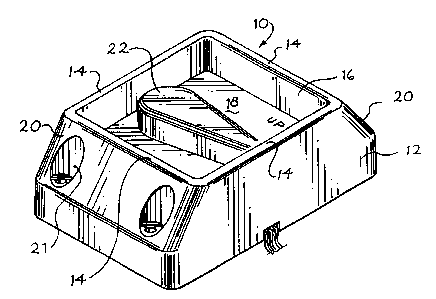Une partie des informations de ce site Web a été fournie par des sources externes. Le gouvernement du Canada n'assume aucune responsabilité concernant la précision, l'actualité ou la fiabilité des informations fournies par les sources externes. Les utilisateurs qui désirent employer cette information devraient consulter directement la source des informations. Le contenu fourni par les sources externes n'est pas assujetti aux exigences sur les langues officielles, la protection des renseignements personnels et l'accessibilité.
L'apparition de différences dans le texte et l'image des Revendications et de l'Abrégé dépend du moment auquel le document est publié. Les textes des Revendications et de l'Abrégé sont affichés :
| (12) Brevet: | (11) CA 2286228 |
|---|---|
| (54) Titre français: | INTERRUPTEUR ELECTRIQUE |
| (54) Titre anglais: | ELECTRICAL SWITCH |
| Statut: | Périmé et au-delà du délai pour l’annulation |
| (51) Classification internationale des brevets (CIB): |
|
|---|---|
| (72) Inventeurs : |
|
| (73) Titulaires : |
|
| (71) Demandeurs : |
|
| (74) Agent: | CASSAN MACLEAN |
| (74) Co-agent: | |
| (45) Délivré: | 2003-04-22 |
| (86) Date de dépôt PCT: | 1999-02-26 |
| (87) Mise à la disponibilité du public: | 1999-09-02 |
| Requête d'examen: | 1999-10-06 |
| Licence disponible: | S.O. |
| Cédé au domaine public: | S.O. |
| (25) Langue des documents déposés: | Anglais |
| Traité de coopération en matière de brevets (PCT): | Oui |
|---|---|
| (86) Numéro de la demande PCT: | PCT/US1999/004320 |
| (87) Numéro de publication internationale PCT: | WO 1999044210 |
| (85) Entrée nationale: | 1999-10-06 |
| (30) Données de priorité de la demande: | ||||||
|---|---|---|---|---|---|---|
|
L'invention concerne un interrupteur électrique qui comprend un boîtier composé de parois s'étendant de manière continue autour d'un évidement. Un actionneur d'interrupteur est monté pivotant dans l'évidement situé dans le boîtier et protégé par les parois. Un premier et un second interrupteur à tiges sont montés dans le boîtier. Un aimant est monté sur l'actionneur d'interrupteur et peut pivoter entre une première position, dans laquelle l'aimant actionne le premier interrupteur à tiges, et une seconde position, dans laquelle l'aimant actionne le second interrupteur à tiges.
An electrical switch (10) includes a housing (12) having walls (14) extending
continuously around a recess (16). A switch actuator (22) is pivotally mounted
in the housing (12) in the recess (16) and protected by the walls (14). First
and second reed switches (30, 32) are mounted in the housing (10), and a
magnet (34) is mounted to the switch actuator (22) and is pivotable between a
first position, in which the magnet (34) activates the first reed switch (30),
and a second position, in which the magnet (34) activates the second reed
switch (32).
Note : Les revendications sont présentées dans la langue officielle dans laquelle elles ont été soumises.
Note : Les descriptions sont présentées dans la langue officielle dans laquelle elles ont été soumises.

2024-08-01 : Dans le cadre de la transition vers les Brevets de nouvelle génération (BNG), la base de données sur les brevets canadiens (BDBC) contient désormais un Historique d'événement plus détaillé, qui reproduit le Journal des événements de notre nouvelle solution interne.
Veuillez noter que les événements débutant par « Inactive : » se réfèrent à des événements qui ne sont plus utilisés dans notre nouvelle solution interne.
Pour une meilleure compréhension de l'état de la demande ou brevet qui figure sur cette page, la rubrique Mise en garde , et les descriptions de Brevet , Historique d'événement , Taxes périodiques et Historique des paiements devraient être consultées.
| Description | Date |
|---|---|
| Le délai pour l'annulation est expiré | 2014-02-26 |
| Lettre envoyée | 2013-02-26 |
| Inactive : CIB de MCD | 2006-03-12 |
| Inactive : TME en retard traitée | 2005-04-05 |
| Lettre envoyée | 2005-02-28 |
| Lettre envoyée | 2004-12-06 |
| Lettre envoyée | 2004-12-06 |
| Accordé par délivrance | 2003-04-22 |
| Inactive : Page couverture publiée | 2003-04-21 |
| Préoctroi | 2002-12-18 |
| Inactive : Taxe finale reçue | 2002-12-18 |
| Un avis d'acceptation est envoyé | 2002-06-28 |
| Lettre envoyée | 2002-06-28 |
| Un avis d'acceptation est envoyé | 2002-06-28 |
| Inactive : Approuvée aux fins d'acceptation (AFA) | 2002-06-14 |
| Modification reçue - modification volontaire | 2002-05-08 |
| Inactive : Dem. de l'examinateur par.30(2) Règles | 2002-01-25 |
| Lettre envoyée | 2001-03-13 |
| Exigences de rétablissement - réputé conforme pour tous les motifs d'abandon | 2001-02-28 |
| Réputée abandonnée - omission de répondre à un avis sur les taxes pour le maintien en état | 2001-02-26 |
| Inactive : Page couverture publiée | 1999-11-29 |
| Inactive : CIB attribuée | 1999-11-23 |
| Inactive : CIB attribuée | 1999-11-23 |
| Inactive : CIB en 1re position | 1999-11-23 |
| Inactive : Acc. récept. de l'entrée phase nat. - RE | 1999-11-10 |
| Lettre envoyée | 1999-11-10 |
| Demande reçue - PCT | 1999-11-08 |
| Toutes les exigences pour l'examen - jugée conforme | 1999-10-06 |
| Exigences pour une requête d'examen - jugée conforme | 1999-10-06 |
| Demande publiée (accessible au public) | 1999-09-02 |
| Date d'abandonnement | Raison | Date de rétablissement |
|---|---|---|
| 2001-02-26 |
Le dernier paiement a été reçu le 2003-02-03
Avis : Si le paiement en totalité n'a pas été reçu au plus tard à la date indiquée, une taxe supplémentaire peut être imposée, soit une des taxes suivantes :
Veuillez vous référer à la page web des taxes sur les brevets de l'OPIC pour voir tous les montants actuels des taxes.
Les titulaires actuels et antérieures au dossier sont affichés en ordre alphabétique.
| Titulaires actuels au dossier |
|---|
| INTELLITEC PRODUCTS LLC |
| Titulaires antérieures au dossier |
|---|
| WILLIAM H. SLAVIK |